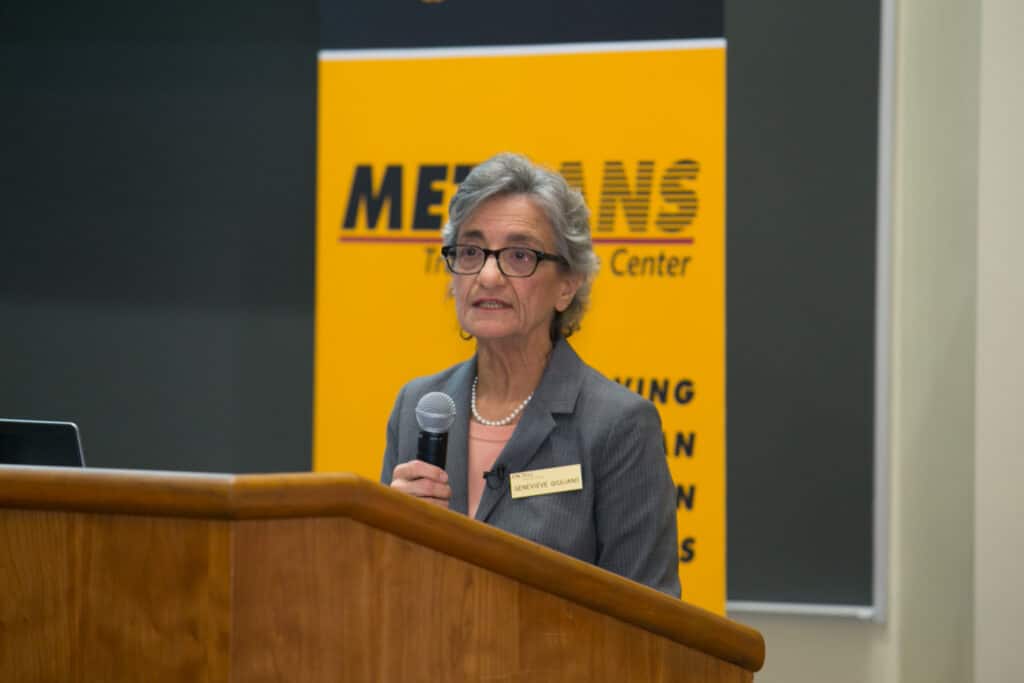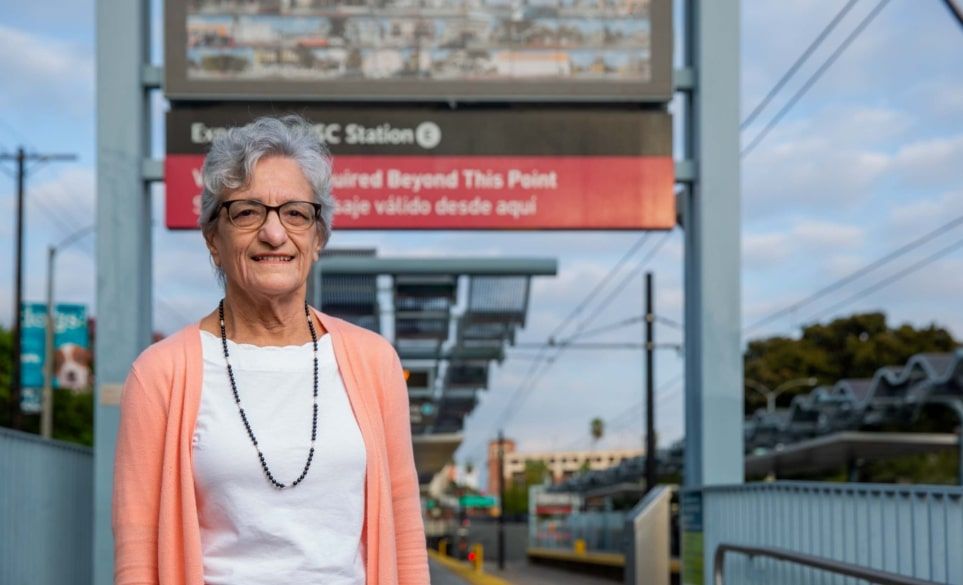Professor Genevieve Giuliano has a landmark year as she continues her passion for transportation-related research
By Greg Hardesty
From her home in Huntington Beach, Professor Genevieve Giuliano loves to hop on her bicycle for leisurely rides along the coast.
Once or twice a week for work, she’ll drive to the USC Sol Price School of Public Policy, where she’s the Margaret and John Ferraro Chair in Effective Local Government. And whenever possible, she’ll use public transportation to attend meetings elsewhere in Los Angeles.
How Giuliano gets around is, on a micro scale, the focus of her distinguished 34-year career at USC.
She’s an expert in travel behavior, transportation policy and metropolitan spatial structure, with some of her current research focused on examining the relationships between urban form, online shopping behavior, and local freight demand.
You could say, literally and scholarly, that Giuliano always has been on the move.
And early this year, Giuliano, who has published more than 200 papers and reports and has lectured around the world, was elected a fellow of the Regional Science Association International (RSAI), which globally recognizes her as a regional scientist with outstanding research credentials.

(Courtesy: Price School)
“I’m very proud of the honor,” says Giuliano, adding with a laugh: “I joke about this kind of recognition sometimes. The reward is more work.”
She’s referring to the scores of student papers she reviews for possible awards from RSAI, an international community of scholars interested in the regional impacts of national or global processes of economic and social change that was founded nearly 70 years ago.
But it’s clear Giuliano’s passion for transportation research hasn’t dimmed since she stumbled into the field as a graduate student at UC Irvine, where she earned a Ph.D. in social sciences.
“I just find this field of research fascinating,” she says.
A research powerhouse
In another milestone this year, Giuliano stepped down as director of the METRANS Transportation Consortium after more than 20 years.
A partnership between USC and Cal State University Long Beach, METRANS’ mission is to solve transportation problems of large metropolitan regions through interdisciplinary research, education, and research.
And it couldn’t be based in a more ideal region – the most congested metropolitan area in the U.S. and home to the largest container port in the country and an airport that is the fourth largest air cargo center in the U.S.
METRANS has grown under Giuliano’s tenure from a small operation to one that conducts about $8 million worth of research every year.
As her successor, Marlon Boarnet, said at the time: “METRANS is incredibly strong, and it’s energizing to think about how you can build from something with such a prestigious track record. Following in the footsteps of somebody like Gen Giuliano is both an honor and, of course, a little daunting.”
Giuliano says it simply was time to make the change, noting that METRANS was one of the first transportation consortiums to examine the movement of freight in cities.
“Nobody was really looking at freight at the time,” she says of METRANS’ establishment in 1998. “Most transportation planning experts think about passengers and people and how people move around the urban environment, but hardly anyone thinks about all those goods that are moving around at the same time and their effects on cities.

“How does freight behave?” Giuliano adds. “What is the difference in the way freight moves around and people move around? Freight packages do not have a choice. You can optimize the way freight moves around, but you can’t really optimize people’s movements, because they have their own ideas.”
Pandemic-related transportation trends may be here to stay
Two big transportation-related trends have come out of the COVID-19 pandemic, Giuliano says, but she’s not certain how things ultimately will shake out.
One trend is changes in consumer behavior.
The market share for online retail sales in the US has rocketed from less than 4% in 2008 to 13.5% in 2021. The global market share in 2021 is about 20%. Online sales continue to grow faster than total retail sales. But the rate of growth is slowing.
“We don’t know when online sales will taper off,” Giuliano says. “It’s not growing as fast as it did in 2021 and 2020, but what happens next will have huge implications for cities.”
The other big change is people working from home. According to a recent report from the U.S. Census Bureau, the percentage of Americans primarily working from home tripled from 5.7% in 2019 to almost 18% in 2021.
“We’re not seeing a wholesale, 100-percent return to the office, but something in between,” Giuliano says. “We don’t know if that’s going to last or if, over time, the system will kind of go back to where it was. It’s too early to tell. And the implications for cities are enormous.”
Giuliano notes that experts have been arguing since the 1980s that the information technology revolution was going to change the role of cities – that as information technology advanced, there would be fewer incentives for workers to commute to urban centers.
“I can do Zoom all the time and text and email, so why would I need to be in the city?” Giuliano asks.
But over the last several decades, cities have continued to grow.
“Those of us who study this say there are really important benefits of being close together,” Giuliano says, “and those benefits, such as the value of meeting someone face to face, are not going away.”
